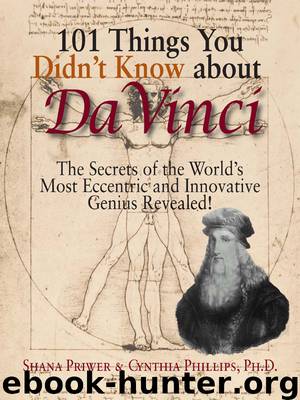101 Things You Didn't Know About Da Vinci by Shana Priwer

Author:Shana Priwer
Language: eng
Format: epub, mobi
Tags: subject
Publisher: F+W Media
Published: 2011-06-24T16:00:00+00:00
51
The perfect man
One of the most famous drawings of all time is Leonardo da Vinci's Vitruvian Man of 1490 (see the cover of this book). In the original sketch, which currently resides in Venice, Leonardo used both ink and watercolor. Leonardo's image has become an icon for art, science, and the Renaissance. Today it's such a widely recognized symbol, you can see it everywhere—in high-school textbooks and museum galleries, even on T-shirts. What is it about this particular drawing that has generated such attention? What is this drawing even about?
The source of inspiration for the Vitruvian Man was, not surprisingly, Vitruvius. But who was he? He was actually a Roman engineer from the first century B.C. who codified some of the first basic principles of architecture. Serving as chief architect under Julius Caesar, Vitruvius was ancient Rome's resident expert in urban planning and structural design, and he wrote the first definitive treatise on architecture, The Ten Books on Architecture (around 27 B.C.), in which he specified guidelines for city planning, building materials, hydraulics, and other civic projects. This influential book also established differences for religious, private, and public designs—the first time that such distinctions had been laid out so clearly. In addition to providing rules and principles for architects to follow, Vitruvius expressed the important relationship between architecture and social-cultural values.
It is likely that Leonardo's first exposure to Vitruvius, and his ideas on form and proportion, came during his apprenticeship to Verrochio. He was also probably influenced by Alberti's interpretations of the same subject. But Leonardo, as usual, came up with his own radical uses and interpretations.
In fact, Leonardo's Vitruvian Man could have been a poster child for Renaissance ideals of humanism and proportion. The drawing consists of a square that is partially inscribed in a circle, with a human male form inscribed into the combination of these two basic geometric shapes. This drawing has become so celebrated because it's the first example of a human form that wasn't forced into an unnatural distortion simply to accommodate the geometry.
Architecture, for Leonardo and most Renaissance architects, was a matter of harmonious modularity. As Leonardo proved with this drawing, it was possible to view the human body the same way: a composition of anatomical building blocks comparable to those of the built world. Interestingly, it's been said that in a not-so-rare moment of artistic hubris, Leonardo may have borrowed his own self-portrait to use for the head of Vitruvius in this influential work! Doesn't it seem appropriate, though, that Leonardo himself might be both model and artist for this symbol of the Renaissance?
Download
101 Things You Didn't Know About Da Vinci by Shana Priwer.mobi
This site does not store any files on its server. We only index and link to content provided by other sites. Please contact the content providers to delete copyright contents if any and email us, we'll remove relevant links or contents immediately.
Hit Refresh by Satya Nadella(9040)
When Breath Becomes Air by Paul Kalanithi(8334)
The Girl Without a Voice by Casey Watson(7824)
A Court of Wings and Ruin by Sarah J. Maas(7653)
Do No Harm Stories of Life, Death and Brain Surgery by Henry Marsh(6891)
Shoe Dog by Phil Knight(5147)
Hunger by Roxane Gay(4869)
The Rules Do Not Apply by Ariel Levy(4866)
A Higher Loyalty: Truth, Lies, and Leadership by James Comey(4851)
Tuesdays with Morrie by Mitch Albom(4696)
Everything Happens for a Reason by Kate Bowler(4680)
The Immortal Life of Henrietta Lacks by Rebecca Skloot(4528)
Millionaire: The Philanderer, Gambler, and Duelist Who Invented Modern Finance by Janet Gleeson(4386)
How to Change Your Mind by Michael Pollan(4292)
All Creatures Great and Small by James Herriot(4233)
The Money Culture by Michael Lewis(4083)
Man and His Symbols by Carl Gustav Jung(4070)
Elon Musk by Ashlee Vance(4033)
Tokyo Vice: An American Reporter on the Police Beat in Japan by Jake Adelstein(3938)
